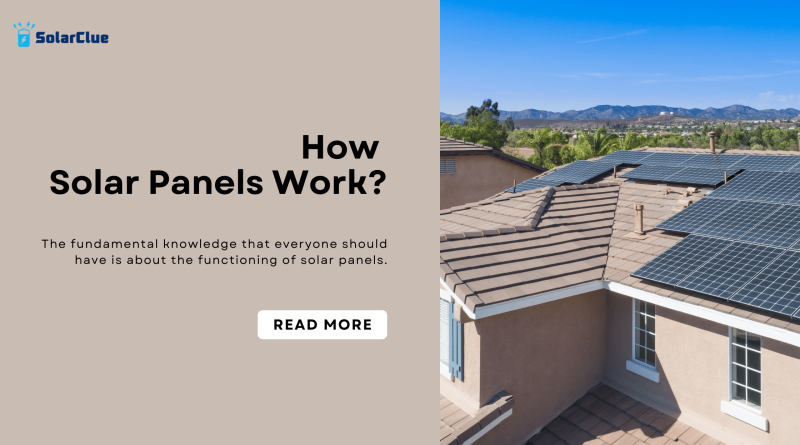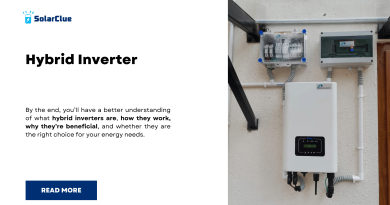How Solar Panels Work?
Solar panels, or photovoltaic (PV) panels, are an innovative and sustainable technology that harnesses the power of sunlight to generate electricity. Understanding how solar panels work involves delving into the science of the photovoltaic effect, the role of key components, and the conversion of sunlight into usable energy. This guide will explore these aspects in detail.
Table of Contents
- 1 Understanding the Photovoltaic Effect
Understanding the Photovoltaic Effect
What is the Photovoltaic Effect?
The photovoltaic effect is the process by which solar panels convert sunlight into electricity. This phenomenon occurs when photons, the basic units of light, interact with certain materials, such as semiconductors, to generate an electric current.
Role of Photons
Photons are particles of light that carry energy. When sunlight hits a solar panel, photons collide with atoms in the semiconductor material, typically silicon, within the solar cells.
Role of Electrons
When photons strike the semiconductor, they transfer their energy to electrons, causing the electrons to become excited and break free from their atoms. These free electrons create an electric current.
Role of Semiconductors
Semiconductors are materials that have electrical conductivity between that of conductors (like metals) and insulators (like glass). Silicon is the most commonly used semiconductor in solar panels due to its efficiency and abundance. In a solar cell, the semiconductor material is treated to create an electric field that directs the movement of free electrons, generating an electric current.
Components of a Solar Panel
Solar Cells
Solar cells are the building blocks of solar panels. Each solar panel contains multiple solar cells connected in series and parallel configurations to maximize electricity production. A solar cell consists of a thin wafer of silicon with a positive and a negative layer that create an electric field.
Junction Box
The junction box is attached to the back of the solar panel and houses the electrical connections and diodes. It serves as the interface between the solar panel and the external electrical system, protecting against reverse current and ensuring safe operation.
Frame
The frame provides structural support and protection for the solar panel. It is typically made of aluminum, which is lightweight and corrosion-resistant, ensuring the panel’s durability and longevity.
Direct Current (DC) vs. Alternating Current (AC) Electricity
Direct Current (DC) Electricity
Solar panels generate direct current (DC) electricity, where the electric charge flows in one direction. DC electricity is suitable for batteries and certain types of electronic devices but is not compatible with the standard electrical grid.
Alternating Current (AC) Electricity
The Role of the Inverter
Conversion of DC to AC
An inverter is a critical component in a solar power system. It converts the DC electricity generated by solar panels into AC electricity, which can be used by standard appliances and fed into the electrical grid.
Types of Inverters
There are several types of inverters, including string inverters, microinverters, and power optimizers. String inverters are the most common, connecting multiple solar panels in series. Microinverters and power optimizers are installed on individual panels, optimizing performance and efficiency.
Efficiency of Solar Panels
Factors Affecting Efficiency
The efficiency of solar panels refers to the percentage of sunlight that is converted into usable electricity. Several factors affect this efficiency:
1. Quality of Materials: Higher quality materials generally lead to better performance and longevity.
2. Temperature: Solar panels are less efficient at higher temperatures.
3. Angle and Orientation: The angle and orientation of the panels relative to the sun impact their ability to capture sunlight.
4. Shading: Shading from trees, buildings, or other obstructions can significantly reduce the efficiency of solar panels.
5. Maintenance: Regular cleaning and maintenance can help maintain optimal performance.
Typical Efficiency Rates
Modern solar panels typically have efficiency rates ranging from 15% to 22%. Research and development are ongoing to create more efficient and cost-effective solar technologies.
Conclusion
Solar panels are a remarkable technology that harnesses the power of sunlight to generate clean, renewable energy. Understanding the photovoltaic effect, the components of a solar panel, the conversion of DC to AC electricity, and the factors affecting efficiency provides a comprehensive view of how solar panels work. As technology advances, solar panels will continue to play a crucial role in the transition to sustainable energy.
Here at SolarClue®, we offer a smart, practical, and “beautiful” solution. You will be answered for all the questions related to Solar.
We provide all kinds of brands that are the Best Solar panels in India.
If you are the one who is planning for the solar power system. Don’t hesitate to contact our team!
Looking forward to empowering you with solar energy, just like hundreds of our other clients!
Frequently Asked Questions
1. How long do solar panels last?
Solar panels typically have a lifespan of 25-30 years, with many maintaining high efficiency beyond this period.
2. Can solar panels work on cloudy days?
3. What maintenance do solar panels require?
Solar panels require minimal maintenance, usually just periodic cleaning to remove dust, dirt, and debris.
4. How much can I save by installing solar panels?
The amount you can save depends on various factors, including your location, energy consumption, and the size of your solar power system.
5. Are there government incentives for installing solar panels?
Many governments offer incentives, such as tax credits and rebates, to encourage the adoption of solar energy. Check with local authorities for available programs.



